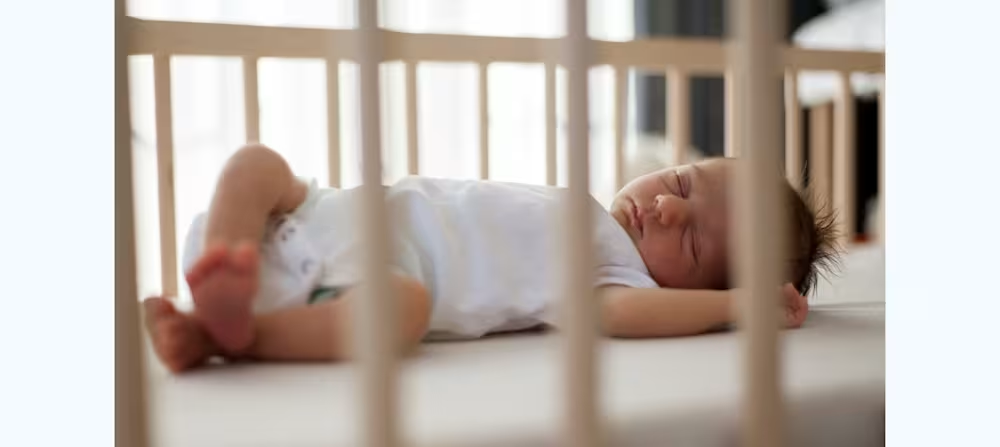Adjusting baby sleep schedules while traveling
Updated Oct 17, 2025

Traveling with a baby? You may have your travel itinerary planned out already, but figuring out your baby’s sleep itinerary may be a little trickier since traveling with infants can throw a wrench in their sleep schedule. For example, you might be in the car during their normal nap time or they might struggle to sleep in a new environment.
With some extra planning and preparation, you can adjust their schedule and help them get that precious shuteye even while away from home. After all, getting enough sleep and staying on a schedule is important for your baby’s well-being — and yours too! In this article, we’ll help give you tips for helping your little one get the sleep they need while traveling, give you ways to prepare for the trip, and help you navigate time zone changes.
Pre-travel preparation for baby sleep schedule
There are many factors to consider when planning your trip and maintaining a sense of normalcy for your baby and their sleep schedule. Even if your trip doesn’t involve any time zone changes, it probably will involve disruptions to your baby’s normal sleep. So what can you do to help manage baby sleep [] while traveling? Prepare, prepare, and prepare some more.
In general, we don’t recommend attempting to shift sleep schedules in advance. Even with the best of intentions and the most thoughtful preparation, schedules and routines will probably be thrown off anyway. For example, if you’re traveling to a different time zone, the light exposure in that new time zone will likely have a big impact on your baby’s ability to sleep. Additionally, schedules will likely be unpredictable while traveling, whether it’s due to a late nap or falling asleep for the night before an ideal bedtime.
Whether you’re adjusting your baby’s sleep schedule or attempting to keep it the same, you’ll also want to practice some naps in the environment you expect them to nap in while traveling. For example, if you’ll be using a portable crib on your trip, give your baby the opportunity to take naps in the new sleep space in a week or two leading up to your departure. Getting them used to new sleep spaces can give you better success at keeping them on a schedule while traveling.
What to pack for sleep while traveling
However, there are many things you can do to help your baby sleep well and mostly stay on schedule once you’re at your destination. For example, as you’re preparing and planning, don’t forget to pack all of their favorite soothing items — whatever you normally use to create a calm and comfy baby sleep environment. Babies often feel more comfortable and sleep better when their home away from home feels like their actual home.
Here are some examples of items you may consider packing:
Sound machine
Blackout curtains
Swaddle or sleep sack
Favorite toys
Blankets
Pacifiers
Baby monitor
It can also be a good idea to pack your own crib sheets even if you’ll be staying in a place that provides them for you. The familiar feel and smell of the sheets might help your baby feel more secure.
Consider travel times and sleep
As you’re planning your trip, you can also think about when you’ll be traveling and how that might affect sleep. If possible, try to travel during times that minimize sleep disruption. This can look different for different families, but you can try leaving about 30 to 45 minutes before bedtime or nap time if you’re traveling by car. This gives your baby some time to get settled in and then hopefully fall asleep so they won’t be starting the trip cranky and overtired.
If your trip is long, the American Academy of Pediatrics (AAP) [] recommends stopping every 2 - 3 hours during the day, and every 4 - 6 hours at night for diaper changes and/or to feed your baby, depending on their age.
According to the AAP, babies can sleep in a properly installed car seat while traveling []. Car seats are designed to protect in a crash and maintain safe sleep positions if the baby dozes off. However, car seats are not suitable for extended sleep when the baby is not being closely monitored. Consider having a responsible older child or adult in the backseat for longer trips.
Follow the manufacturer's instructions for the installation angle helps prevent your baby's head from slumping and blocking their airway. Ensure the five-point harness is properly adjusted and snug at all times while in the car.
Some families may be tempted to start their road-trip at bedtime, but we don’t suggest driving through the night. In addition to being a safety concern for your little one, it will likely be very hard to parent the next day. It can also be dangerous to drive through the night [] when you’re tired, especially when you’re traveling with precious cargo!
If you’re traveling by plane, consider choosing a flight during a time when your child will likely be awake, if possible, since naps may not happen in-flight. If you’re taking a long flight, a redeye may seem like the ideal choice so your baby can sleep for a long stretch. However, this can backfire and make for a rough night and the next day. It can be easier to recover from a day of poor napping than a poor night’s sleep.
Baby sleep schedule during travel
Once you’ve left home base, the real work begins. It’s not uncommon to want to do whatever you can to help your baby sleep [] according to your desired schedule, whatever that may be. Typically, keeping your child on their normal schedule leads to better quality sleep and better moods. However, while we don't expect a baby to strictly adhere to their normal schedule when away, we can try our best to maintain some consistency, as that can help ensure everyone gets enough rest.
As much as you may want your baby to stay on a strict schedule, it’s OK to let things slide some of the time so that you can have fun experiences and spend quality time with family and friends. When you’re traveling, the timing of meals and sleep isn’t always entirely within your control. Sometimes you might want a little flexibility, too.
Whether your baby stays strictly on schedule or you change things up a bit, they might need to take a nap in their car seat or while you hold them on a plane. Note that AAP safe sleep practices [] recommend moving your little one to a firm, flat surface for sleep as soon as possible.
To help your little one sleep while in transit (whatever that transit looks like) so that they stay on schedule, there are many things you can do to help them feel comfortable. Here are a few tips:
Use a sound machine to help drown out other noises
Replicate your normal baby bedtime routine as much as possible (read a book, sing a song, change into comfy clothes, etc.)
Bring something that smells like home, such as a favorite toy or blanket
How to manage time zone changes while traveling
As your baby’s internal clock develops, it may become more difficult for them to adjust their sleep schedule while traveling. Typically, their sleep-wake cycle is determined in large part by their internal clock once they’re six months or older. This means that if you’re changing time zones, it may be physically difficult for them to go to bed at their regular time in the new time zone.
If you’re not dealing with major time zone changes or only traveling for a short period, you might be able to get away with keeping your baby on the same schedule if desired. For example, if your baby normally goes to bed at 8 PM and the place you’re traveling to is 2 hours ahead, keeping your baby on the same schedule means they’ll go to bed at 10 PM in the new time zone. This can be helpful because you won’t be attempting to change your child’s internal clock or need to worry about getting back on schedule when you return home. It might help your baby be in a better mood during the trip too. However, this might mean missing out on certain aspects of your trip due to shifted bedtimes or rise times.
In some cases, you may want to adjust to a new time zone. Adjusting sleep schedules may make it easier to enjoy activities during your trip, visit with family and friends, and share meals at culturally appropriate times. If you decide to make a shift to the new time zone, it’s ideal to adjust your baby’s nap and meal times gradually. Even if you skip or add a nap to help your baby get used to a new time zone schedule, it can be difficult for them and sleep may not go according to plan. It can even be hard for adults to adjust to different time zones!
If you do decide to adjust your baby’s sleep schedule, especially if you’re many hours off your regular time zone, it can be difficult to determine when your baby is ready for sleep. Huckleberry’s SweetSpot® sleep predictor can make it easier to find optimal nap and bedtimes. Get free access for 2 weeks as a new member!
Things can get a bit trickier when you’re dealing with multiple and you might want to consider sleep schedule changes:
If traveling east to west, your baby will need to stay up later to adjust to the new time zone.
For example, 8:00 PM in California will feel like 11:00 PM to a baby from New York. While you’re traveling and on the first couple days of your trip, you can try offering an extra nap to help your baby make it to bedtime without getting too overtired. Use light to your advantage. Exposing them to light in the evening can suppress melatonin, and shift their schedule later. Keep lights off in the morning until your desired wake time.
If traveling west to east, your baby might want to party through the night, as they’re not physically able to go to bed hours earlier.
For example, 8:00 PM in New York will feel like 5:00 PM for a baby from California, and they may not be able to sleep until 11:00 PM in the new time zone. In some cases, this works to your advantage because it allows you to stay up a little bit later than normal and enjoy nighttime activities like going out to eat. If you want your baby to go to bed earlier, you can try cutting their last nap short or skipping it altogether, though they may still treat “bedtime” like a nap if it’s out of sync with their internal clock.
It takes time to shift a schedule.
Adjusting to a new time zone typically takes about one day for each hour of time difference. For example, if you're traveling to a location that is three hours ahead of your home time zone, it may take about three days for your body to fully adjust. However, individual experiences can vary based on factors such as age, health, and sleep habits and we find that babies and children can take longer to adjust.
If you typically follow a pretty strict sleep routine, you might consider being a little more flexible while you travel. There may be late naps and bedtimes, and that’s OK! You can get back into your normal routine and sleep habits when you return home.
Tips and tricks to try to help baby sleep while traveling
Tip #1: Understand that baby might not be physically able to sleep at a different time
Once babies are about 6 months old, their internal clock is pretty well developed. Since their internal clock governs sleep-wake rhythms, it may be very difficult for them to sleep at a time that doesn’t align with their typical schedule. Even if they’re tired and sleep pressure (homeostatic sleep drive) has built up, they still may have trouble falling asleep at 6:00 PM, for example, when their body is used to falling asleep at 8:00 PM. Be prepared with some quiet activities that can keep baby calm in a dim or dark room if they can’t physically sleep.
Tip #2: Keep the room dark during sleep time
Keeping the room dark can be helpful when trying to get your child to sleep at a desired time, especially if your baby is adjusting to a new time zone. Then, expose them to bright light in the morning when it’s time to wake up to help sync their internal clock.
Tip #3: Artificially adjust light if needed
If you want to keep your baby on their regular sleep schedule and that doesn’t match up with the natural light in the place you’re traveling you may need to artificially adjust the light inside your accommodations. Darken the room during sleep time and lighten it during wake times to match your home schedule.
Tip #4: Replicate baby’s home sleep environment as much as possible
The success of adjusting baby sleep while traveling depends on whether you’re able to get your baby to sleep at the desired time or not. Once you arrive at your destination, try to replicate their sleep environment, whether that means using a portable blackout shade to cover light coming in from windows or bringing your travel crib from home.
Tip #5: Maintain familiar bedtime routines
Your travel sleep routine should follow your regular bedtime routine as much as possible, and don’t assume your baby will need extra help falling asleep. Changing the way you put them to sleep (rocking vs patting their back, for example) might actually throw them off. Give them a chance to fall asleep the way they usually do before you try to add in more interventions.
Tip #6: Find an appropriate sleep space
Getting your baby to sleep might prove tricky depending on what type of sleep space you have. For example, if you’re staying with family and friends, you might need to talk to them ahead of time about the best place for your baby to sleep. In a hotel room, you might have to sit in quiet darkness while your baby naps next to you in their travel crib. Someday you’ll look back and laugh about all of the things you had to do to get your baby to sleep while on vacation!
Tip #7: Follow safe sleep guidelines
Take care to follow safe sleep protocols while traveling in a new environment, too. For example, make sure you’re positioning your baby’s sleep space far enough away from outlets, curtains, cords, and other potential hazards. Bringing a baby monitor from home can also be helpful so you can monitor your little one while they sleep.
Takeaway
Your baby’s sleep schedule and environment are not going to be exactly the same as at home. Accepting that sleep will likely be bumpy while you travel can take away some of the stress. Keep in mind this is temporary!
Replicating your little one’s sleep environment from home, using light to your advantage when adjusting sleep schedules, and sticking to your normal routine — even if the timing is different — are all helpful tips for adjusting your baby’s sleep schedule while traveling.
Even with the best planning, things may still go awry. Regardless, your baby will sleep, and you can get back into a regular sleep schedule when you return from your travels.
Baby sleep schedule while traveling FAQ
Share article:
Note: The content on this site is for informational purposes only and should not replace medical advice from your doctor, pediatrician, or medical professional. If you have questions or concerns, you should contact a medical professional.





